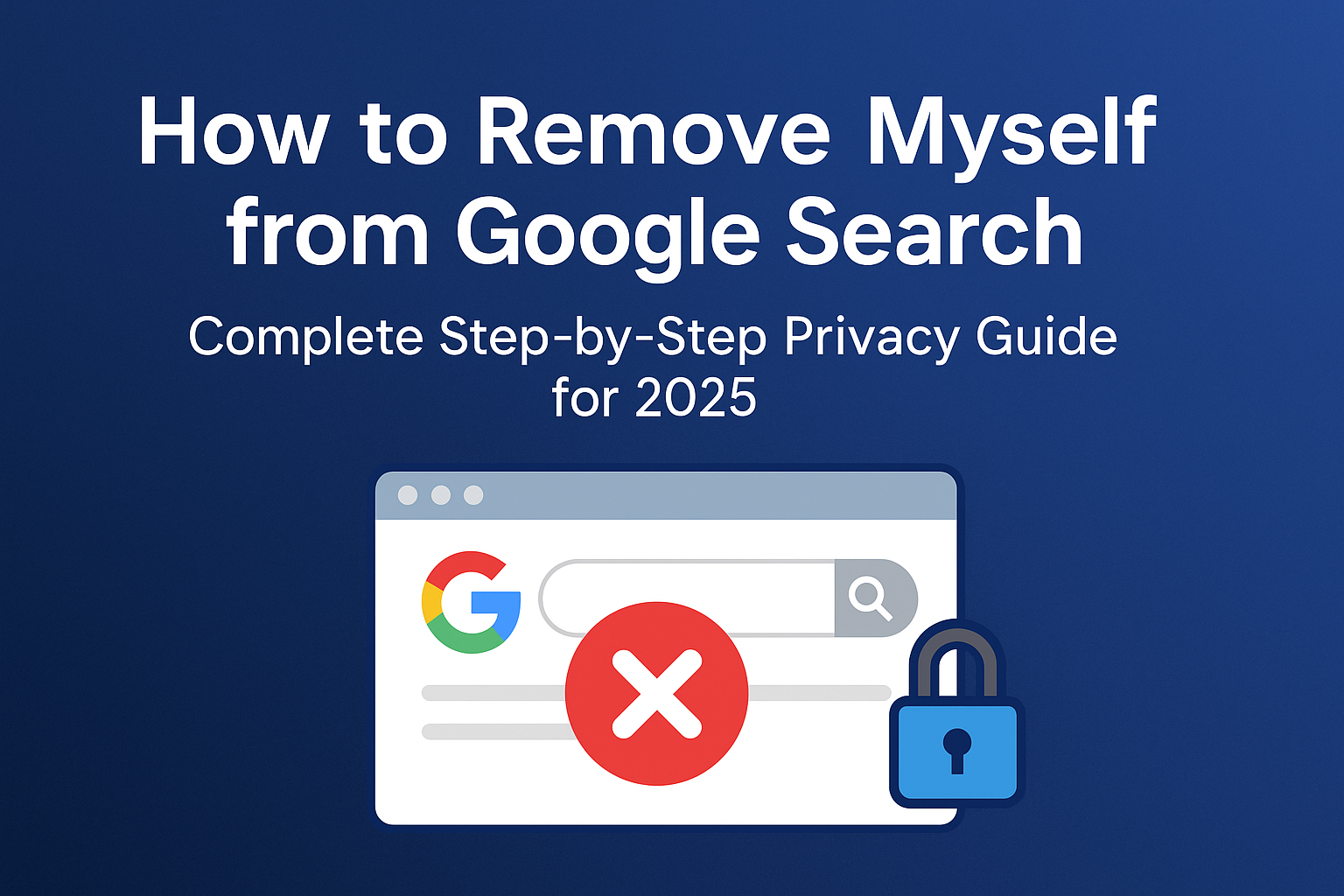Estimated reading time: 5 minutes
Why People Want to Remove Themselves from Google
The internet never forgets. A single search for your name may reveal:
- Old social media profiles
- Contact details (phone numbers, home address)
- Embarrassing news mentions
- Past court filings or mugshots
- Blog posts or comments you’d rather leave behind
Whether you’re protecting your career, personal safety, or peace of mind, learning to remove yourself from Google search is an essential privacy skill in 2025.
What Google Can and Cannot Remove
Google Can Remove:
- Explicit personal identifiers (e.g., ID numbers, Social Security numbers).
- Financial account details (credit cards, bank accounts).
- Intimate or non-consensual images.
- Doxxing content (address, phone, or email published maliciously).
- Outdated or irrelevant information under the Right to Be Forgotten (for EU residents).
Google Cannot Remove:
- Accurate public records (like property deeds, voter registrations).
- News coverage with legitimate public interest.
- Opinions, commentary, or reviews—even negative ones—if legally permissible.
Understanding these limitations prevents frustration and helps you focus on actionable strategies.
Step-by-Step: How to Remove Myself from Google Search
Step 1: Search for Yourself
Use variations of your name:
- “John A. Smith”
- “John Smith + City”
- “John Smith + employer”
Document every unwanted link in a spreadsheet.
Step 2: Remove Information from the Source
Google doesn’t host content; it indexes it.
- Delete old social media accounts.
- Deactivate unused profiles.
- Contact site administrators to request removals.
Step 3: Use Google’s Removal Tools
Google offers multiple forms:
- Remove outdated content – for deleted pages still appearing in search.
- Personal information removal request – for addresses, phone numbers, or doxxing.
Example code block:
Google Request Form:
https://support.google.com/websearch/troubleshooter/3111061
Step 4: Suppress with Positive Content
When removal isn’t possible, push down negative results:
- Launch a professional website.
- Publish blog articles.
- Optimize LinkedIn and portfolio pages for your name.
Step 5: Monitor Regularly
Set up Google Alerts for your name:
https://www.google.com/alerts
This ensures you’re notified when new pages appear.
Advanced Strategies to Remove Yourself from Google
Opt Out of Data Brokers
Sites like Radaris, Spokeo, and PeopleFinders republish your info. Submitting opt-out requests reduces reappearance.
Use Privacy Services
Professional removal services (like Remove Online Information) handle bulk requests and monitoring.
Replace Personal Identifiers
- Use a P.O. Box instead of your home address.
- Switch to a VOIP number for registrations.
Legal Tools
- GDPR requests (for EU residents).
- CCPA requests (for California residents).
- Defamation takedowns (for false damaging content).
North America vs. Europe: Different Rights
- Europe: The “Right to Be Forgotten” (GDPR) allows individuals to request removal of outdated or irrelevant data.
- U.S.: Focused on free speech protections, making removals harder unless data is sensitive, outdated, or unlawful.
Common Myths About Removing Yourself from Google
- Myth 1: Google owns your information.
False—Google indexes content but doesn’t create it. - Myth 2: You can delete everything.
False—public interest content and accurate public records remain. - Myth 3: Deleting a profile erases it instantly.
False—cached results may linger for weeks.
Case Study: A Professional’s Reputation Cleanup
A North Carolina teacher found that old court records and outdated blog posts dominated her Google search results. She:
- Contacted site owners for takedowns.
- Filed outdated content requests.
- Launched a personal website optimized for her full name.
Within 6 months, unwanted links dropped from page one, replaced with professional content.
Why DIY Isn’t Always Enough
Even after filing removals, your name often resurfaces:
- Data brokers repopulate records.
- New mentions appear in blogs or forums.
- Old cache entries remain.
That’s why professional monitoring and suppression are vital.
How Remove Online Information Helps
Remove Online Information provides:
- Bulk removals across dozens of broker sites.
- Search suppression to push down harmful results.
- Ongoing monitoring to protect your online footprint.
- Customized privacy strategies for individuals and businesses.
📌 Want to erase your information from Google? Start today with Remove Online Information.
FAQ: How to Remove Myself from Google Search
No. You can significantly reduce visibility, but some records remain.
Typically 7–14 days for Google’s review, but cached results may last longer.
Yes, for sensitive data like ID numbers or addresses.
Not unless they violate Google’s review policies or are defamatory.
Removal erases; suppression pushes results off page one.
Yes, but only under specific guidelines.
Some, like GDPR, apply only in specific regions.
Yes. Many addresses come from data broker sites. Opt out of those directories and file Google removal requests for pages exposing your location.
Yes. Services like Remove Online Information specialize in this.
At least quarterly, or monthly if your career is sensitive.
Yes, if they’re explicit, non-consensual, or violate policies.
Yes. Google typically informs the site owner when their page is de-indexed, although your personal information is not disclosed.
Quick Checklist
- ✅ Audit Google for your name
- ✅ Remove info at the source
- ✅ File Google removal requests
- ✅ Suppress results with positive content
- ✅ Opt out of data brokers
- ✅ Replace identifiers (P.O. Box, VOIP number)
- ✅ Monitor quarterly with Google Alerts
- ✅ Get professional help if needed
Learning how to remove yourself from Google search in 2025 is about persistence. While you may not erase every trace, you can drastically reduce your visibility and regain control over your online identity.
Remove Online Information ensures that sensitive details stay hidden while building a protective strategy around your reputation.
👉 Ready to protect your privacy? Visit Remove Online Information today.
Works Cited (MLA Format)
Federal Trade Commission. Protecting Your Privacy Online. FTC, 2025, https://www.ftc.gov/.
Google. Remove Outdated Content. Google Search Help, 2025, https://search.google.com/search-console/remove-outdated-content.
Google. Request Removal of Personal Information. Google Support, 2025, https://support.google.com/websearch/troubleshooter/3111061.
Electronic Frontier Foundation. Surveillance Self-Defense. EFF, 2025, https://ssd.eff.org/.
National Conference of State Legislatures. Data Privacy Laws. NCSL, 2025, https://www.ncsl.org/.

